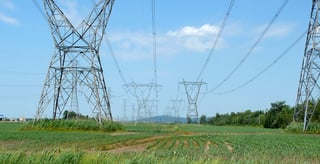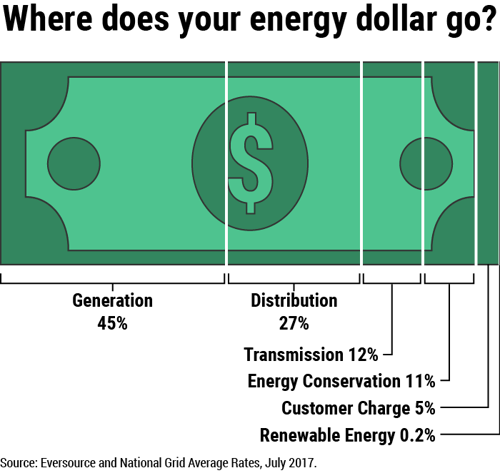Who Does Our Electricity Bill Money Go To
The average Massachusetts and Rhode Island household uses about 600 kilowatt-hours (kWh) of electricity every month. At about 20 cents for every kWh, this amounts to an electrical bill of $120 a month. Hither's a guide to meliorate understand where that money is going. In that location are two major sections to your bill, the Delivery portion and the Supply portion. These represent both how much it costs to generate the power you use, plus the cost of getting that power from the betoken of generation to your habitation. While yous have some selection about how your electricity is generated, which is reflected in the Supplier Services section of your neb, the Delivery charges are determined by your electricity company and are regulated by the Section of Public Utilities in Massachusetts and past the Public Utilities Commission in Rhode Island. Distributionis the biggest role of your delivery charges. The Delivery charges are similar for both states. Distribution is the biggest part of your delivery charges, and includes the cost of maintaining the poles and wires connecting your home to the electric filigree, also every bit billing and other authoritative costs. Transmission covers the costs associated with the highvoltage wires and towers that you see marching beyond the countryside, connecting power plants to the grid. Together these add up to virtually 40% of the average total electric pecker. The client charge is a fixed amount that doesn't vary depending on how much energy you lot use. You can think of this as your membership fee at the gym. You pay it only so yous tin can utilise it, and it'south the same whether you nourish xxx classes or just i. If you don't employ much electricity, yourclient charge will take up a larger per centum of your total bill, and conversely if you use a lot of electricity, your customer charge volition be a smaller per centum. For the average ratepayer this amounts to about 5% of your nib. Both states also take a modest charge to support Energy Conservation or Free energy Efficiency. This charge funds the Mass Salve and Free energy Wise RI programs and related efforts to help us reduce our demand to invest in new electricity generation facilities. Free energy efficiency programs as well assist keep your overall energy bills affordable past helping yous trim your electric consumption without sacrificing comfort. In both states, the efficiency programs are ostensibly designed to invest in all cost-effective energy saving measures, with "price constructive" defined as costing less than the cost of buying energy supply. For example, if it costs less to install LED lightbulbs in a dwelling house or office building, the utilities should practise that rather than buy more power from the market, whether the ability is generated from fossil fuels or renewable energy. In practice, The average household pays less than 11% to efficiency programs in Mass. and 7% in Rhode Island. Program evaluations evidence both states are getting a great rate of return on their efficiency investments, and that Massachusetts is garnering greater benefits than Rhode Island as a result of its college investment. The percentage of your overall bill tied to Supplier Services varies over time with the cost of generation and the quantity of electricity your home uses. In the average neb, supplier costs currently business relationship for 45% of the total monthly electrical nib. The bodily per centum changes yr past year equally the toll of supply changes with market atmospheric condition. Distribution and transmission costs besides change but less frequently. In New England, increasingly, ability plants are rewarded non just for free energy they generate, but too for demonstrating their power to reliably come on-line when needed to meet demand. These rewards are called "capacity" payments. Most chapters payments are made to natural gas power plants, but renewable energy and free energy efficiency likewise authorize. This twelvemonth, in some parts of Massachusetts, capacity payments account for about a third of the supply charge to consumers. When you open an electrical account, you are automatically enrolled in the utility's Basic Service. Customers tin opt for a competitive supplier to switch away from the utility'due south supply, but buyers beware! Often competitive suppliers can't beat out the cost per kWh of the utility's standard offer for very long for individual accounts. Merely Mass Energy/PP&50 sources renewable energy exclusively from New England generators. Bones supply is a mix of both green and brown electricity from all the generators in our regional grid. The renewable energy content increases slightly every twelvemonth thanks to state mandates. Some competitive suppliers may claim to offering cheap green options, but as our members know, the blazon and location of the renewable energy projects you are sourcing from determines how effective that buy is in fighting the impacts of climate modify. Merely Mass Energy/PP&L sources renewable energy exclusively from New England generators. Suppliers that "greenwash" boast about clean energy, but a closer look proves that their sources are way out of our region and exercise little to zero to improve our local emissions. We posted a blog article reflecting on the importance of effective green electricity. Before yous sign any contract with a supplier, it's important to read the fine print to understand the potential charges on your pecker and free energy sources. Remember, if yous are a National Grid customer yous must be enrolled in Bones Service for your supply to participate in Mass Free energy/PP&Fifty'southward green power program. Green Power members can feel expert knowing that their electric usage is matched with local green sources. And you lot can keep the costs of your electric neb manageable by improving the energy efficiency of your dwelling house. More data for Mass residents here and RI residents here. Mass Energy and People's Power & Light actively advocate for policies that keep your electric bill fair and transparent, while investing today for a sustainable future. If y'all have any questions, feel gratis to reach out at greenreply@massenergy.org and greenreply@ripower.org. 
Delivery Charges


Energy Efficiency Pays for Itself
 the programs fall far short of using all cost-effective efficiency measures to keep our electrical costs under command. Evaluations point out that benefits of those programs exceed their costs by approximately three to i, which means that the programs are passing up opportunities to salve say, $2.00 for every $1 spent.
the programs fall far short of using all cost-effective efficiency measures to keep our electrical costs under command. Evaluations point out that benefits of those programs exceed their costs by approximately three to i, which means that the programs are passing up opportunities to salve say, $2.00 for every $1 spent.Supplier Charges
Basic Service vs Competitive Supply
Lesser Line

Tags: Electricity and the filigree
Source: https://blog.greenenergyconsumers.org/blog/electric-bill-deconstructed
Posted by: ayondeffords.blogspot.com

0 Response to "Who Does Our Electricity Bill Money Go To"
Post a Comment